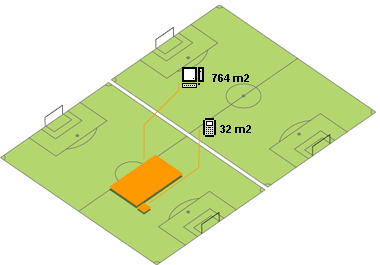Our individual ’fair earth share’
If we divide all productive space on earth by the number of people on it, we each have 1.8 hectares of the planet to provide for our needs – our fair earth share. This is equivalent to two football pitches. On average, 566 phones and 24 PCs would each use up the available earth share for one ’world average citizen’.
The Ecological Footprint (EF) measures the human demands on the biosphere by comparing humanity’s consumption against the Earth’s biocapacity (i.e. its regenerative capacity). It does this by calculating the area required to produce the resources people consume, the area occupied by infrastructure, and the area of forest required for sequestering CO2 that is not absorbed by oceans. On a product level and here in the WEEE man context, the EF has been applied to find out how much productive space ("nature") is required to manufacture an electronic or electrical product (EEE) and to absorb the emissions that are generated when producing and operating it.
The footprint can capture the main environmental impacts – carbon emissions - that arise from manufacturing and using a product. Whilst the principle of the EF has not changed – comparing humans´ demand for resources with the Earth´s capacity to supply them – our global EF has further increased with now exceeding the Earth´s biocapacity by more than 50% in 2008.
The “available biocapacity” per person decreased from 3.2 global hectares (gha) in 1961 to 1.8 gha per capita in 2008 , even though total global biocapacity increased over this time This means that rising consumption in high-income groups around the world and in Brazil, Russia, India, Indonesia, China and South Africa - coupled with a growing human population, provide a worrying signal for even larger human footprints in the future.
Since the launch of the WEEE man project the EF methodology has been further developed and adjusted.
Footprinting mobile phones and PCs
When you buy a mobile phone, it uses about 32 (global) square metres, which is less than 1% of your ’fair earth share’. The footprint for a PC is about 764 square metres or 4% of the average earth share (newer PCs may do better). For both products, more than 90% of the land space used is for absorbing carbon emissions.
When does the waste take place?
One paradox of the WEEE Directive is the notion that it deals with the ’waste’ generated by electrical and electronic products. In reality, most waste comes from the material processes, energy and emissions that are generated throughout the stages of a product’s life cycle -raw material extraction, parts manufacture and use – not disposal, which has a relatively low overall environmental impact.
The impact of raw material extraction
About 90% of the material waste generated by mobile phones comes at the raw material extraction phase. For example, the production of 1 tonne of platinum requires the removal of 950,000 tonnes of ore. For gold, the ratio between material extracted (such as rubble, earth) and product is around 1:350,000 tonnes. On this basis a solid Gold WEEE Man would be generate around a million tonnes of material waste at the extraction phase alone.
Using recycled material in new products can reduce the need for raw material extraction. Recycling 1kg of aluminium saves 8kg of bauxite, 4kg of chemical products and 14kw of electricity.
The impact of the use phase
In many products, the use phase generates significant environmental burdens. Around 99kg of CO2 are generated by a typical mobile phone during its use phase, compared to 6kg in the raw material phase. The typical phone generates more than 750 times its own weight in carbon dioxide over its lifetime.
Carbon Footprint and Ecological Footprint
Today, the term “carbon footprint” (CF) is mostly used as a metric for the amount of carbon emitted by an activity or organisation (often expressed in carbon dioxide equivalents to include a range of other greenhouse gases, and expressed in tonnes or kilogrammes). For products , and especially EEE, this CF is a better metric due to the inclusion of six greenhouse gas groups according to the Kyoto Protocol (carbon dioxide, methane, nitrous oxide, sulphur hexafluoride, hyrofluorocarbons and perfluorocarbons), and in particular when complemented with other environmental indicators that cannot be addressed by theecological fooptprint (EF) such as . toxicity.
In contrast, the carbon component of the EF takes a different approach by translating the amount of carbon dioxide into the area of productive land and sea required to sequester carbon dioxide emissions. This tells us the demand on the planet that results from burning fossil fuels. Measuring it in this way has advantages when assessing the EF of nations or subnational areas. Here, the EF shows us how carbon emissions compare and interact with other elements of human demand, i.e. the pressure we place on food sources, the amount of “renewable” resources required to make the goods we consume, and the amount of land we take out of production when we build towns and roads.
The carbon footprint component of the EF is currently 54% of our overall EF and is also it’s fastest growing component - having increased 11-fold since 1961.
This work has been developed by Dr Sibylle Frey, of Giraffe Innovation Limited, based on her Phd study at Brunel University
www.giraffeinnovation.com
|

